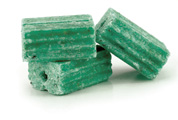Before the holidays, a puppy of Brody and Suri’s, Chloe passed away from eating poisonous mushrooms. Chloe and her parents are one of our most memorable puppy people as we lovingly call them. Jessica was so happy to be bringing Chloe home that she cried, and her and her husband Dan almost walked out the door with the wrong puppy! They were so excited. A few years later they bought Teddy from us, a Tucker and Suri puppy. We just wanted to take some time and let everyone know the dangers of things that are outdoors, and even in your own home that can be harmful and potentially deadly to your dogs. All of our dogs are like our children, and we treat them like our babies all of their lives. A lot of times Cavaliers have a tendency to be like hoovers and eat whatever is on the ground or floor. We always tell people that once you leave, our door is not shut, and we mean that from the bottom of our hearts. We may only have them for 8 weeks but they stay in our hearts forever, and so do the wonderful people that buy them. So please read the posting below and keep all of these things in mind when you are at home with your dog, or outdoors. And please pass on this information to anyone watching your precious puppies.
NOTE:
As far as household cleaners, almost a year ago we switched all our cleaners at Angel Pawz to Green Cleaning products. From soap, to disinfectants, to Bathroom and Kitchen Cleaners. This means our animals can literally eat our laundry soap and nothing happens to them. All the Products we use for the dogs can be found at Amway.com/KristynTholen The products are called Legacy of Clean and are no more expensive than Tide, Bleach, Mr. Clean. You get an incredible clean for a good price and non of it can harm you, your children, or your furry children. Legacy of Clean is the leading brand in non-toxic, non-chemical cleaning products. They are super concentrated so you even use less of these products than you do of your current products.
Outdoor Poisons (things found right in your own backyard)
Blood meal:
This is dried, ground, and flash-frozen blood and contains 12% nitrogen. While it’s a great organic fertilizer, if ingested, it can cause vomiting (of some other poor animal’s blood) and diarrhea. More importantly, it can result in severe pancreatitis, which is inflammation of the pancreas. Some types of blood meal are also fortified with iron, resulting in iron toxicity, so make sure to know what’s in your bag of blood!

Blue–green algae or Cyanobacteria:
Growth of toxic algae can be found in both fresh and salt water throughout the warm regions of the world. Blue-green algae becomes concerning when algae accumulates on the surface of the water during hot, dry weather with wind that can shift concentrated algae mats along the shorelines. Affected water may have the appearance of pea soup with thick layers of algae on the surface. Blooms of blue-green algae can contain hepatoxins and/or neurotoxins, depending on the species. Exposures occur when dogs ingest or swim in water that contains the cyanobateria. Clinical signs with the hepatoxin variety are vomiting, diarrhea, lethargy, weakness, shock, icterus (yellow gums), and potentially death within 24 hours to several days. Clinical signs seen with ingestion of the neurotoxin species occur acutely with onset of tremors, lethargy, seizures, difficult breathing, and death within a hour.

Bone Meal:
This is made up of defatted, dried, and flash-frozen animal bones that are ground to a powder. This “bone” is also what makes it so palatable to your dog, so make sure to keep your pet from digging in it and ingesting the soil. While this also makes a great organic fertilizer, it can become a problem when consumed as the bone meal forms a large cement-like bone ball in the stomach – which can cause an obstruction in the gastrointestinal tract – resulting in possible surgery to remove it!

Compost bins or piles:
While we applaud you for composting, make sure to do so appropriately – your compost shouldn’t contain any dairy or meat products, and should always be fenced off for the sake of your pets and wildlife. These piles of decomposing and decaying organic matter and molding food products have the potential to contain tremorgenic mycotoxins, which are toxic to both pets and wildlife. Even small amounts ingested can result in clinical signs within 30 minutes to several hours. Clinical signs include agitation, hyperthermia, hyper-responsiveness, panting, drooling, and vomiting, and can progress to serious CNS signs (including incoordination, tremors, and seizures!). Ruleouts for this include toxins that cause “shake and bake,” such as metaldehydes (snail bait), strychnine, organophosphates, and methylxanthines. Prompt decontamination is the key if the patient isn’t demonstrating clinical signs yet – this includes inducing vomiting and giving activated charcoal. Once the patient is symptomatic, aggressive supportive care includes the use of IV fluids, temperature regulation, cooling methods (cooling down to a temperature of 103.5⁰ F/39.7⁰ C), IV muscle relaxants (methocarbamol), and anticonvulsants (i.e., diazepam, phenobarbital).
Fireworks:
These can result in burns; injury to the mouth, eyes, or paws; and possible heavy metal toxicity if ingestion. Fireworks can contain iron, copper, barium, mercury, phosphorus and magnesium in the coloring agents.1 The amount of heavy metal varies widely, depending on the type of fireworks, quantity ingested, and coloring agent used.1 Clinical symptoms seen with fireworks ingestion include vomiting, diarrhea, jaundice, tremors and seizures. Induction of emesis and activated charcoal are not recommended and animals should be immediately evaluated at a veterinary clinic for injury.

Iron:
This is commonly added to fertilizers, and can result in iron toxicity (from ingestion of elemental iron). This is different from “total” iron ingestion, and can be confusing to differentiate. When in doubt, have a medical professional at Pet Poison Helpline assist you with finding out if the amount ingested was toxic or not. Large ingestions can result in vomiting, bloody diarrhea, and potential cardiac and liver effects.
Mulch Products:

Cocoa bean mulch, a byproduct of chocolate production, is the discarded hulls or shells of the cocoa bean. This mulch is frequently used for home landscaping and is often very fragrant, especially when first placed in the yard and warmed by the sun. This tempting smell of warm chocolate often attracts and encourages dogs (Labradors!) to ingest the mulch. Through the processing procedure of creating cocoa bean mulch, much of the methylxanthine poison is removed, but still potentially contains 0.19% to 2.98% theobromine and 0.5% to 0.85% caffeine. All animals can be affected by methyxanthylates, but dogs tend to have more frequent exposure opportunities to the chocolates, coffee beans and cocoa mulch that contain them. Clinical signs include vomiting, diarrhea, hyperactivity, tremors, tachycardia, tachypnea, and potential seizures. Symptoms are dose-dependent and an accurate dose is very difficult to determine because of the variation of the concentration of methyxanthylates from one mulch product to next.
There have been anecdotal reports of a dog dying after ingesting cocoa bean shell mulch, and this has been rapidly circulating on the Internet. That said, how toxic is this stuff, really? The first report of this poisoning was actually reported by Pet Poison Helpline’s Drs. Lynn Hovda and R. Kingston at the 1993 International Congress of Clinical Toxicology. Dr. Steve Hansen from ASPCA published this again 10 years later (Clin Tox 2003;41:5). Recently, Dr. Hansen stated that the cause of the one fatality ( a young Labrador) was “highly suspect.” While theobromine and caffeine (methylxanthines) can be toxic, clinical signs are usually more PROGRESSIVE – such as vomiting, diarrhea, more vomiting, trembling, a racing heart rate, and then seizures in very high doses. Cocoa bean mulch is very unlikely to result in sudden death without showing other signs. Nevertheless, play it safe and don’t allow pets to ingest this product! Typically, after a first rain, the smell dissipates, making the mulch less attractive to pets.
Mushrooms:

There are various types of mushrooms located throughout the United States that may be non-toxic; however, other types of mushrooms may be very dangerous and include general groups that are gastric irritants, hallucinogenic, or hepatotoxic (from cyclopeptides, hydrazine toxins, isoxazoles, or psilocybin compounds). The latter group includes Amanita mushrooms, which can result in acute hepatic necrosis (i.e., liver failure).
While the frequency of dangerous mushroom toxicity is likely very low, the lack of readily available identification of mushrooms lands all ingestions in the category of toxic until proven otherwise. With ingestion of any mushroom, immediate emesis is recommended, provided the animal is alert, asymptomatic, and able to adequately protect his or her upper airway. Gastric lavage may be necessary for animals already exhibiting clinical signs. Clinical symptoms are dependent on the species of mushroom ingested, the specific toxin within that mushroom, and the individual’s own susceptibility. Early clinical signs include vomiting, diarrhea, abdominal pain, ataxia, depression, tremors, and seizures, with liver and renal damage occurring later. One can collect all the pieces of the mushroom in a paper towel, place them in a labeled (DO NOT EAT! POISONOUS) paper bag, and refrigerate the sample for future possible identification. If you see your dog eat a mushroom, contact your veterinarian or Pet Poison Helpline immediately! Better yet, make sure to scour your yard frequently and get rid of any mushrooms growing out there!
Mouse and rat poisons (rodenticides):

As we prepare to winterize our garage, cabin, or house, keep in mind that there are some more dangerous rat poisons to pick from than others. Always make sure to place these poisonous baits in areas where your pet can’t reach them (i.e., high up on shelves, hidden behind work spaces, etc.). Currently there are four separate categories of rodenticides available for general use. Each has a different and unique mechanism of action. This results in four different sets of clinical signs in both the target rodent population and our curious pets who might consume them. All of these rodenticides also pose the potential for “relay toxicity”– in other words, if your dog eats a whole bunch of dead mice poisoned by rodenticides, they can get the secondary effects from this. This is most commonly seen in birds of prey (i.e., raptors), so we generally recommend avoiding them in the first place!
- Long-acting anticoagulants (LAACs): By far the most well-known and perhaps most widely used rodenticides are the LAACS. This family of rodenticides works by causing internal bleeding and preventing the body from clotting normally. Common signs include coughing (blood in the lungs), large and soft lumps under the skin, vomiting, nose bleeds, bruised skin, exercise intolerance, weakness, bloody urine, bleeding from the gums, and inappetance. With LAACS, it takes 2-5 days before the poison actually takes effect and before clinical signs of bleeding, but chronic ingestion shortens the time period. If there is any suspicion of ingestion, a prothrombin test, usually referred to as a PT test, supports the diagnosis (it takes 48 hours after ingestion before this PT test will be abnormal). Fortunately, prescription-strength Vitamin K1, the antidote, is routinely found in most veterinary offices.
- Cholecalciferol (Vitamin D3): One of the most dangerous rat poisons out there is a Vitamin D3-based rodenticide. This type basically increases calcium blood levels so high that it causes a secondary kidney failure. With this type of rat poison, only a tiny amount needs to be ingested before it causes a problem, and long-term, expensive treatment is usually necessary. This is the type to avoid in your garage, as it has no antidote!
- Bromethalin: This rarer type of rat poison doesn’t have an antidote and results in brain swelling. If toxic amounts are ingested, we see clinical signs of walking drunk, tremoring, and seizuring. Treatment is symptomatic and may require an extended amount of time in the veterinary hospital due to long-lasting effects (days up to a week).
- Phosphides: This type of poison is more commonly seen in mole and gopher poison, and typically doesn’t come in the classic blue-green or yellow blocks or pellets. Phosphide rodenticides typically come in a poisoned “gummy worm” form that you put in the dirt. These types of phosphide poisons result in phosphine gas in the stomach, resulting in severe bloat, profuse vomiting, abdominal pain, and potential lung and heart complications. Like cholecalciferol poisons, it only takes a small amount of poison to cause a big problem! Make sure to keep these toxins away from your pets, as this type can be poisonous to you too (if you inhale the phosphine gas if your dog vomits!).
Rose and plant fertilizers:
Some of these fertilizers contain disulfoton or other types of organophosphates (OP). As little as 1 teaspoon of 1% disulfoton can kill a 55 lb dog, so be careful! Organophosphates, while less commonly used, can result in severe symptoms [including SLUD signs (which abbreviate for salivation, lacrimation, urination, and defecation), seizures, difficulty breathing, hyperthermia, etc. In some cases, it can be fatal!
Pesticides/Insecticides:
Most pesticides or insecticides (typically those that come in a spray can) are basic irritants to the pet and are usually not a huge concern unless a pet’s symptoms become persistent. Some may contain an organophosphate which can be life threatening when consumed in large quantities. It is always best to speak to a trained medical professional if there are any questions.
Slug and Snail Baits:
Slug and snail baits are commonly used on the West coast and in warm-weather conditions, and are available in a variety of forms (pellets, granular, powder, and liquid). The active ingredient is typically metaldehyde, which is toxic to all species (particularly dogs).2 When ingested, metaldehyde results in clinical signs that resulted in the nickname “shake and bake.” Within 1 to 2 hours of ingestion, clinical signs of salivation, restlessness, vomiting, and incoordination are seen, which then progress to tremors, seizures, and secondary severe hyperthermia. Treatment consists of early decontamination, supportive care, temperature regulation (cooling down to a temperature of 103.5⁰ F/39.7⁰ C), anticonvulsants, and muscle relaxants. Generally, the prognosis is favorable if treatment is quickly and aggressively implemented.
Inside Poisons
Kitchen
Ammonia, bug sprays and traps, cleansers/disinfectants (including floor, carpet, oven, window and other cleaners), drain openers, medicines (both prescription and over-the-counter), polish (for furniture, metals or glass), soaps/detergents, vitamins/supplements/diet pills and other dietary supplements
Bathroom
All medicines (both prescription and over-the-counter), aftershave lotion, alcohol/hydrogen peroxide, bath oil, cleansers/disinfectants (including floor, window, toilet bowl, and tub/tile cleaners), deodorizers/sanitizers, drain openers, hair removers, hair colors/permanents, mouthwash, ointments, shampoo/hair products
Bedroom
Cosmetics (including nail polish/remover, perfumes/colognes), all medicines (including cough medicine, prescription drugs, and sleeping aids), mothballs, ointments
Laundry
Bleaches, cleaning fluids, soaps/detergents, stain removers, spray starch
Other
Alcoholic beverages, cigarettes, nicotine patches, medicines (including prescription or over-the-counter, and pet medicine), poisonous plants (such as poison ivy, oak or sumac and some household plants)












